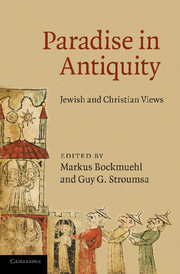Book contents
- Frontmatter
- Contents
- Notes on contributors
- 1 Introduction: the paradise chronotrope
- PART I PARADISES OF SECOND TEMPLE JUDAISM AND CHRISTIAN ORIGINS
- PART II CONTEMPORIZING PARADISE IN LATE ANTIQUITY
- 15 Epilogue: a heaven on earth
- Select bibliography
- Index of subjects
- Index of authors (cited in text)
- Index of sources
- References
15 - Epilogue: a heaven on earth
Published online by Cambridge University Press: 06 December 2010
- Frontmatter
- Contents
- Notes on contributors
- 1 Introduction: the paradise chronotrope
- PART I PARADISES OF SECOND TEMPLE JUDAISM AND CHRISTIAN ORIGINS
- PART II CONTEMPORIZING PARADISE IN LATE ANTIQUITY
- 15 Epilogue: a heaven on earth
- Select bibliography
- Index of subjects
- Index of authors (cited in text)
- Index of sources
- References
Summary
A celebrated sage of the first century, Rabban Gamaliel, taught his students that in the world to come, “trees will give fruit every day.” The Babylonian Talmud relates that one of Gamaliel's students scoffed at him, saying, “But it is written, ‘There is nothing new under the sun.’” The Rabbi did not throw the arrogant student out. Instead he replied, “Come, and I will show you an example in this world.” He went outside with the students, and showed them a caper bush. Indeed, during its lengthy flowering season between April and October, the caper produces new flowers every day. Here was something on earth which anticipated the dimension of eternity.
Faced with the challenge of decoding the meaning and explaining the characteristics of the original perfect location described in the Book of Genesis – the earthly paradise – as a garden with trees and rivers, late-antique Jewish and Christian exegetes had to speculate about heaven and earth, letter and allegory, time and eternity. Their task involved discussing polarities such as soul and body, spirit and matter, and speculating on what on earth could anticipate the dimension of eternity. Was the Genesis account to be taken literally or did the sacred text point to a deeper layer of meaning? Was Adam's paradise a real park somewhere on earth or a heavenly reality? Was the Garden of Eden to be regarded as a state fixed in eternity or as a condition inserted into the flux of history? Where was it?
- Type
- Chapter
- Information
- Paradise in AntiquityJewish and Christian Views, pp. 210 - 220Publisher: Cambridge University PressPrint publication year: 2010
References
- 1
- Cited by



